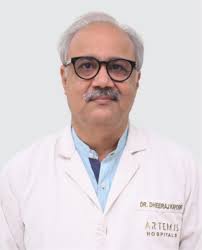General Surgery
Surgery for Benign Scrotal Lumps Treatment
Benign Scrotal Lumps Surgery
A benign scrotal lump is a lump in the patient’s scrotum that is not being caused by cancer. There are three types of Benign Scrotal Lumps.
What are Benign Scrotal Lumps?
A benign scrotal lump is a lump in the patient’s scrotum that is not being caused by cancer.
There are three types of Benign Scrotal Lumps, which are as follows:
- Hydrocele: A hydrocele, where fluid builds up in the sheath around the patient’s testicle. A hydrocele is a collection of serous fluid between the tunica albuginea and tunica vaginalis of the testis, caused by an imbalance in the continual production and reabsorption of fluid. Hydroceles are classified into primary, the most common variety, or secondary (caused by trauma, tumor or infection, for example).
- Epididymal cyst: An epididymal cyst, where the fluid is being collected in the epididymis (a tube-like structure that contains sperm). These benign, fluid-filled, thin-walled cysts are found posterior to the testis, usually in the upper or lower pole of the epididymis. It is thought that about 30 percent of men have one or more of these cysts, which, in themselves, pose no serious threat.
- Sperm Granuloma: A sperm granuloma is being caused by sperm leaking which is followed by a vasectomy. Sperm granuloma arises secondary to sperm leakage following vasectomy. They may present any time from the intermediate postoperative period onwards and are usually small, hard, tender swellings localized to the site of the division of the vasa deferentia. Again, examination of the erect patient will reveal a small pea-shaped swelling above and definitely separate from the body of the testis. An inguinoscrotal hernia can be excluded by getting above the swelling
Some facts about Benign Scrotal Lumps
- The vast majorities of swellings in the scrotum are benign and should not give a major concern to the patients,
- Benign swellings in the scrotum only need a surgical treatment if they result in some notable symptoms (e.g. cosmetic embarrassment aching,),
- A simple ultrasound scan will generally differentiate between cancerous swellings and benign,
- If the lump is being attached to the surface of the patient’s testicle, it has the high chances that it is benign;
- If a lump is present within the body of the testis itself, there are almost 90% of chances that it is testicular cancer,
- Testicular cancer is the commonest malignant tumors in men between the age of 20 and 50 years old;
- The testicular cancer is very rare among the men, who are over the age of 50, certain forms do occur and the patients should always seek advice from their GP,
- Testicular cancer is usually in abnormal testicles e.g. previously undescended testicles, testicles which have been infected or injured and soft, atrophic testicles (sometimes this is viewed in the infertile men), and
- Early diagnosis and treatment mean that more than 95 percent of the patients can be cured of testicular cancer, even if cancer has been spread beyond the testicle itself.
What are the benefits of the Surgery for the Benign Scrotal Lumps?
If the lump is large, the surgical procedure will ease any discomfort the patient may have and thus making it easier for the patients to walk. If the patients have any desire to have children, it is in the best option to leave an epididymal cyst alone. Surgery in the site of the epididymis can cause scarring which may reduce the patient’s fertility.
Need for the Surgery for Benign Scrotal Lumps Treatment
If the benign scrotal lumps present symptoms or are large and the cause of the lump is known, surgery may be required in extreme circumstances.
Here are some factors that may indicate the need for surgery:
- Pain or Discomfort
- Size or Growth
- Infection
- Diagnosis
- Recurrence of Symptoms
Symptoms of Benign Scrotal Lumps
It is now the nature of the disease’s symptoms that depends upon the type of lump and the nature of the disease itself.
Here are some common symptoms:
- Painless Lump
- Swelling or Enlargement
- Pain or Discomfort
- Tenderness or Sensitivity
- Changes in Scrotal Appearance
- Heavy or Full Sensation
- Infertility
What complications can happen?
General complications that caused to the patients when undergoing the surgery for Benign Scrotal Lumps are as follows:
- Pain
- Bleeding
- Difficulty in the passage of the urine
Specific complications that caused to the patients when undergoing the surgery for Benign Scrotal Lumps are as follows:
- Infection of the surgical wound (site)
- Fertility is being reduced if the surgery is being performed for treating an epididymal cyst
Causes of Benign Scrotal Lumps
Common morphological causes of benign scrotal lumps include a number of conditions that are not malignant. These lumps may be the result of cysts, fluids or pathology of the blood vessels in the scrotum.
Below are some common causes of benign scrotal lumps:
- Epididymal Cysts
- Hydrocele
- Varicocele
- Spermatic Cord Lipoma
- Testicular Torsion
- Infections
- Scrotal Hernia
- Testicular Cancer
- Post-Surgical or Post-Traumatic Lumps
- Dermoid Cysts
- Keloid Scarring
Facilities and Services offered for International Patients for Removal of Benign Scrotal Lumps
The majority of medical institutions treat foreign patients diagnosed with benign scrotal lumps. Such centres are normally equipped with a full package of services in order to meet the needs of patients coming from other countries when it comes to achieving proper health care, comfort and support in the process of treatment.
Here are some key facilities and services commonly offered for scrotal cyst treatment:
- Multilingual Support
- Medical Consultations
- Tailored Treatment Plans
- Advanced Diagnostic and Lab Facilities
- Minimally Invasive Surgery Options
- Expert Surgical Teams
- Assistance with Travel and Accommodation
- Post-Treatment Follow-up Services
- Visa Assistance
Pre-Treatment Process for Benign Scrotal Lumps
The main approach to the benign scrotal lumps management indicates that before the treatment, several stages should be passed in order to diagnose the condition, to determine the most suitable treatment method, and to prepare the patient for the operation.
Here’s an overview of the typical pre-treatment process:
- Initial Consultation
- Diagnostic Imaging
- Laboratory Tests
- Review of Treatment Options
- Pre-Surgical Preparation
Diagnostic Tests for Benign Scrotal Lump Surgery
As with all lumps in the scrotal region, the diagnosis involves being certain of the nature of the lump, the exact site of the lump, and the fitness of the patient for surgery. Here are the common diagnostic tests used in the pre-surgical evaluation for benign scrotal lumps:
- Physical Examination
- Scrotal Ultrasound
- Transillumination
- MRI
- Doppler Ultrasound
- Blood Tests
- Urinalysis
- Electrocardiogram
Procedure for the Benign Scrotal Lumps:
Surgery for removing the benign scrotal lumps is generally done under a general anesthetic. Sometimes a spinal anesthetic can also be used. The operation generally takes between twenty to fifty minutes, depending on the situation. The patient’s surgeon will make a small incision in the patient’s scrotum. For a hydrocele, the patient’s surgeon will be required to remove the fluid from the sheath and either removing the sheath or stitch it back together. The patient’s surgeon will remove an epididymal cyst. This will generally involve removing a part or all of the epididymis. The operation is generally done under a general anesthetic. The operation generally does not take more than 50 minutes.
Post-Treatment Process for Benign Scrotal Lumps
The general management of benign scrotal lumps that have undergone treatment or surgery includes assignment of a strict follow up procedure to ensure adequate healing and the least number of complications are likely to occur while observing the patient’s health.
Here is a typical post-treatment process:
- Immediate Post-Operative Care
- Discharge Instructions
- Pain and Swelling Management
- Medication Regimen
- Monitoring for Complications
- Gradual Return to Normal Activities
- Lifestyle Recommendations for Recovery
- Follow-up Appointments and Monitoring
- Long-Term Care and Monitoring
Are there any alternatives to surgery for Benign Scrotal Lumps?
The fluid can be removed using a needle but the fluid generally builds up again after some time. It is possible that a drug may be injecting that ultimately stops the fluid from coming back again.
Success Rate of Benign Scrotal Lump Surgery Treatment
Benign scrotal lump surgery treatment is usually very effective with success rates ranging from 95 to 98% most of whom will have no more symptoms or have the condition cured.
How soon will the patients recover?
The patients should be able to go home the same day as the surgery is performed or the day after the surgery is performed. Most of the men can return back to their day to day activities within two to four weeks. Regular exercise should help the patients to return to their day to day activities as quickly as possible. Before the patients start exercising, they must ask a member of the healthcare team or their GP for some advice. Sometimes the lump can come back. For a hydrocele, surgery generally cures the problem. However, fluid can build up again. There is usually more than one epididymal cyst and surgeries are only able to treat the larger ones. If the smaller ones get bigger with the time, the problem will come back.
Best Hospitals for Benign Scrotal Lumps Surgery
- Artemis Hospital, Gurgaon
- Manipal Hospital, Gurgaon
- Marengo Asia Hospital, Gurgaon
- Medanta The Medicity, Gurgaon
Best Doctors for Benign Scrotal Lumps Surgery
- Dr. Rajiv Yadav
- Dr. Amit Kumar Tiwari
- Dr. Rajeev Sood
- Dr. Rajesh Kumar Ahlawat
Why Choose GetWellGo for Surgery for Benign Scrotal Lumps Treatment?
The choice of GetWellGo for benign scrotal lumps treatment has some privileges that can attract foreign patients.
Here are key reasons why GetWellGo might be the right choice for this procedure:
- Experienced Medical Team
- Advanced Diagnostic and Treatment Technology
- Comprehensive Care for International patients
- Customized Treatment Plans
- High Success Rates
- Holistic Post-Operative Care and Follow-up
- Focus on Patient Comfort and Minimizing Recovery Time
- Transparent Pricing
- Transport and Accommodation Options
Conclusion
Surgical intervention for benign scrotal lumps is often a safe, effective, and minimally invasive and a highly successful method of symptom control, and relief from discomfort and decreased risk of complications which may arise if left untreated. The procedure may be less invasive and therefore enables the patient to recover faster, intimate scarring as well as has a low rate of recurrence when the surgery is done by professional surgeons. Good prognostic outcomes depend on the pre-operative diagnostics, detailed planning of the operation, and adequate post-operative treatment.
FAQs
1. What is the advantage of surgical treatment of benign scrotal lumps?
- Surgery may be for a long while and will then offer permanent solution to pains, swelling and other discomforts. It can also reduce the risk of other problems that come with neglected lumps like infections or growth and is a permanent solution that is all the more important if other therapies have not worked.
2. What is the prognosis for surgery in patients with benign scrotal masses?
- Success rates are typically high overall - between 90 and 98 % depending on the type of lump and the surgery. For instance, a hydrocele and spermatocele surgery does not usually recur and varicocele surgery has a re-occurrence rate of 10-15 % only.
3. What is the rate of recovery for a benign scrotal lump surgery?
- Recovery duration depends on the kind of surgery that is done on the patient. In general, it should take from 2-4 weeks for patients to recover completely. Normally, the therapy of the minimal invasive procedures is more rapid than the conventional treatment since the majority of the patients are able to go about their daily activities with less interruption in two weeks. In regard to the categories of lifting, it may be possible to fully recover including returning to an ability to do strenuous physical work in as little as 4 to 6 weeks.
TREATMENT-RELATED QUESTIONS
GetWellGo will provide you end-to-end guidance and assistance and that will include finding relevant and the best doctors for you in India.
A relationship manager from GetWellGo will be assigned to you who will prepare your case, share with multiple doctors and hospitals and get back to you with a treatment plan, cost of treatment and other useful information. The relationship manager will take care of all details related to your visit and successful return & recovery.
Yes, if you wish GetWellGo can assist you in getting your appointments fixed with multiple doctors and hospitals, which will assist you in getting the second opinion and will help you in cost comparison as well.
Yes, our professional medical team will help you in getting the estimated cost for the treatment. The cost as you may be aware depends on the medical condition, the choice of treatment, the type of room opted for etc. All your medical history and essential treatment details would be analyzed by the team of experts in the hospitals. They will also provide you with the various types of rooms/accommodation packages available and you have to make the selection. Charges are likely to vary by the type of room you take.
You have to check with your health insurance provider for the details.
The price that you get from GetWellGo is directly from the hospital, it is also discounted and lowest possible in most cases. We help you in getting the best price possible.
No, we don't charge patients for any service or convenience fee. All healthcare services GetWellGo provide are free of cost.
Top Doctors for General Surgery
Top Hospitals for General Surgery
Contact Us Now!
Fill the form below to get in touch with our experts.







